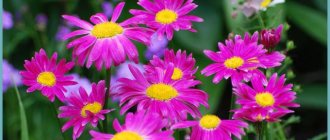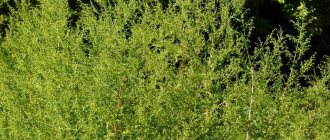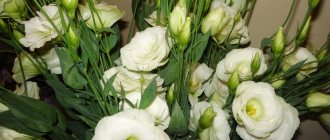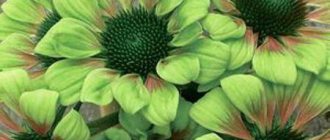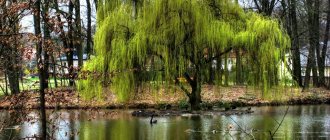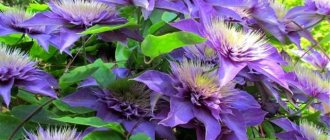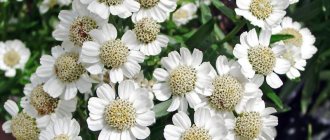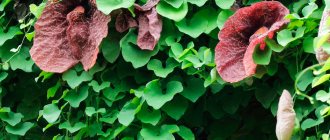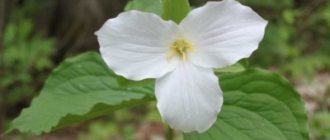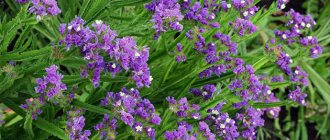Description and features
Garden bellflower is a herbaceous plant from the Campanaceae family. Grows in temperate latitudes with a continental climate. There are more than 400 species of this crop. Presented as an annual, biennial or perennial. Often used to decorate flower beds.
The stem can be erect, creeping or branched. The plant can be short, medium-sized or tall (up to 1.55 meters in length). The root system is taproot or rhizomatous. The leaves are arranged in regular order.
They are oblong, lanceolate or semicircular in shape, with a serrated, zigzag or smooth edge. The size of the leaf blades and the length of the petioles gradually decrease towards the tip of the shoot. At the base of the stem there are basal leaves. The flower is very similar to a glass or bell. Inflorescences are racemose or paniculate. The flower is bisexual, regular, on a peduncle. May have blue, white, blue color.
It blooms all summer and is pollinated by bees. After pollination, a fruit is formed - a capsule with tiny seeds inside. Propagated by seed or vegetatively.
The coloring pigment that gives the bluebell its delicate blue color is susceptible to acids. If you plant a flower in acidic soil, it will instantly turn red. This feature of the plant can be used to determine the acidity of the soil. You can sprinkle a freshly cut bell with soil and watch the reaction. If it changes color to scarlet, it means the soil is very acidic.
Bellflower peach
Distributed throughout the European part of Russia and other CIS countries. A recognizable inhabitant of wild meadows and forests. In nature, it most often has blue flowers and reproduces by self-sowing. Rarer varieties have white and purple inflorescences.
Bell description:
- perennial;
- height from 40 to 100 cm and above;
- stem erect;
- leaves lanceolate, narrow, dark green;
- bell inflorescences are collected in brushes of 3-8 pieces;
- flowering period – June-July;
- The fruit capsule ripens in September.
Bellflower prefers well-drained soils and partial shade. In nature, it is found on the edges of forests, in wet ravines, along river banks in the shade of bushes. When grown in the garden, it does not require fertilizing or watering. Used as a secondary and third plant. Young leaves and roots of the plant can be used for food.
Growing seedlings from seeds
In the spring you can sow bells for seedlings. The seed is preliminarily kept in the refrigerator, on a shelf with vegetables, for 2 months.
Sowing time
Seeds are sown in pots with substrate in March. Closer to summer, they are transferred to a flower bed.
Soil requirements
For planting, take soil that is not too heavy, consisting of garden (turf) soil, sand, peat, compost (humus). All ingredients are taken in equal parts.
Planting scheme
The seeds are poured onto well-moistened soil at a distance of 1 centimeter from each other, sprinkled with sand. Then it is irrigated with water and covered with transparent glass on top.
Temperature and light conditions
Boxes with seeds are kept in a room with an air temperature of 19-23 degrees Celsius. After 2-3 weeks, the seeds germinate. As soon as the shoots appear, the boxes are transferred to the windowsill, closer to sunlight. It is advisable to highlight the seedlings in the evening. Daylight hours should be 10 hours.
Watering
The seedlings need to be constantly looked after, irrigate the soil with water from time to time, and ensure that the soil does not dry out. You can loosen the soil, removing the hard soil crust.
Dive
The bells peak when the seedlings are three weeks old. By this period the plant should have 2-3 true leaves. Seedlings are planted in separate pots or plastic cups. 2 weeks after picking, the plants are fed with complex fertilizer of low concentration.
Transfer
At the end of spring, when the soil warms up to 10 degrees Celsius and the air temperature is 15 degrees, the bell seedlings are transplanted into a flower bed. The soil is dug up and fertilized before planting. For seedlings, shallow holes are prepared and the plant is transferred to the flowerbed using the transfer method, together with a lump of earth.
How to grow, care
Landing
- First of all, we fill the planting container with nutritious soil, which should include manure and turf soil. We loosen the soil and water it.
- We plant the seeds to a depth of no more than 2 cm, and then sprinkle them with earth. Seed preparation must begin in early spring.
- We place the container with planting in a bright place with a temperature of at least 18°C. As soon as the first shoots appear, we loosen the seedlings, water them and remove diseased leaves. Seedlings should grow in a planting container for no more than 3 weeks.
- We transplant the seedlings into open ground in May or June. It is important that the site has enough sunlight.
- Before planting, dig the soil to a depth of at least 20 cm, and then apply fertilizer (it is better if it is manure).
- We make small holes and plant seedlings in them, while maintaining a distance between the holes - it should be at least 15 cm.
Care
- We water these garden plants exclusively in hot weather. Bluebells do not need to be watered regularly.
- We water the bushes at the root, but do not allow water to get on the inflorescences and foliage.
- After watering, thoroughly loosen the soil and remove weeds.
- We fertilize twice a season. First, we apply nitrogen fertilizers in the spring (when the snow has just melted), and then we use complex fertilizers as a top dressing - we apply them while the plant is gaining color.
- To ensure that the bells bloom for a long time, we regularly remove dried inflorescences.
Planting in open ground
Bluebells are a heat-loving and light-loving crop. It is advisable to plant grown seedlings in the garden at the end of spring.
Deadlines
In mid (late) May, when the air warms up to 14-15 degrees Celsius, the seeds can be sown immediately in the garden. At the same time, you can plant pre-prepared seedlings. They practice winter planting, in which case the seeds are sown in the garden bed in October.
Selecting a location
They like to grow in open, sunny garden areas. They do not tolerate swampy, heavy, acidic soils.
How to select and prepare soil
They grow on loamy or sandy loam, non-acidic soils. They prefer soil that is not too heavy and loose and has neutral acidity. Heavily clay soil is diluted with peat, sand and compost. In poor soil, additional turf and minerals are added.
Disembarkation rules
It is advisable to prepare the land for planting in advance. The area needs to be thoroughly dug up, weeds removed, loosened, compost and superphosphate added. Soil acidity can be reduced by adding a little wood ash. Bluebells are planted away from tall plants. The distance to the neighboring flower should be 15-40 centimeters. After planting, the soil is lightly compacted and irrigated abundantly.
Reproduction of bluebells
One-year-old bells reproduce exclusively by seeds, while biennial bells can be propagated both by seeds and by cuttings obtained from new shoots of the second year of life. Perennial plants can reproduce by any means - both by seeds and cuttings, by dividing a bush, by root shoots, and so on.
True, there is one exception to this rule: terry species do not form seeds, so they can reproduce exclusively by vegetative methods.
The seed propagation method, which is so complex and time-consuming for many other plants, is very simple to implement for bells. As noted earlier, if you don’t want to bother with seedlings, you can simply plant the seeds in October and the next year they will all germinate together and all that’s left to do is just plant them. And in another year they will bloom profusely and produce seeds for the next generation.
Bluebell variety Border Blues
Cuttings are traditionally carried out in the spring and young root shoots grown this year are used for it. After which they are germinated either in water or in a special substrate until roots appear. When the first roots appear (usually the end of May), the petiole is planted in open ground.
Long-columnar bell
Dividing a bush in bluebells is possible only in the 3-4th year of their life , since the tap root system grows “in breadth” for a long time, however, there are species capable of this method of reproduction already in the second year after planting or replanting. Usually, a similar procedure is done in May.
Care
Bluebell is an unpretentious crop that requires a minimum of attention. Caring for it is no different from caring for other garden crops.
Watering
It is necessary to water occasionally, only in drought and hot weather. Prefers moderate watering. Take settled water, not hard, preferably rainwater.
Loosening and weeding
The soil near the bells must be constantly loosened and weeds removed. Be sure to break up the hard soil crust.
Garter to support
Tall bells need to be tied to a support. Pegs or mesh are used as support.
Feeding
In the spring, during the growth period, the flower crop can be fed with nitrogen supplements. You can add a little wood ash and rotted manure to the soil. Before flowering, the soil is fertilized with potassium and phosphorus substances at the rate of 35 grams per 1 square meter of area.
Trimming
Bells will bloom for a long time if you constantly remove fading flower stalks. In autumn, the stems of the plant should be completely cut off.
Pests and diseases
Bluebells rarely get sick. True, if grown for many years in the same place, they can develop a fungal infection (fusarium, sclerotinia, botrytis). As a preventive measure, plants are sprayed with a fungicide solution (Fundazol) in the spring. Bluebells are often attacked by insects, such as slobbering pennies. They can be prevented by spraying with garlic solution or insecticide.
Tincture of hot pepper and mulch made of sand or sawdust protect against slugs.
Stepsoning
The stems of the plant need to be pinched, removing excess lateral or apical shoots. It is advisable to remove dried leaves and flowers from the bush.
Mulching
The ground near the plants can be mulched with sawdust or small pebbles and sand. Mulch helps retain moisture in the soil and prevents weeds from breaking through.
Topping
The top of the stem should be pinched at the very beginning of summer. This procedure stimulates the growth of side shoots, and the stem will not stretch too much.
Medium bell
A resident of the foothills of the Caucasus, Siberia and even America, the middle bell is a biennial herbaceous plant. Known in garden culture since the 16th century. Loves moist soils, coolness and does not tolerate heat and frost.
Description of the plant:
- height from 50 to 100 cm;
- stem straight, pubescent;
- basal rosette of leaves;
- the diameter of the flowers is 6-7 cm, located along the entire length of the stem;
- flowering from June to August;
- inflorescences are blue, white, pink or purple.
In a favorable climate, the plant reproduces by self-sowing, the seeds ripen in August-September. The flower is considered a good honey plant. Its inflorescences bloom alternately from bottom to top, which is why it has such a long decorative period.
How and when to plant? Cultivation of medium bellflower from seeds is carried out by planting in seedling boxes or in open ground. In the first case, you can achieve flowering of the biennial this year, and in the second case, in the future.
If you sow bellflower seedlings, choose the period from late January to February.
The seeds are not sprinkled with soil; they are germinated in containers in the light. The seedlings are transplanted to a permanent location in May-June. At first it is a dense rosette of leaves, which produces 1 stem with alternately forming buds. The bell will bloom in July of this year and next year in June.
To get a strong plant next year, the seeds are sown in open ground in June and lightly sprinkled with soil. Until autumn, the young rosettes will get stronger and are transplanted to a permanent place. The distance between plants is at least 10 cm. After 2 years, the planting is renewed.
Reproduction
The culture is propagated by seeds or vegetatively, that is, by cuttings, by dividing the rhizome. Each variety has its own method of reproduction.
Annuals
They reproduce exclusively by seed. The seeds can be sown in a flower bed in October. Over the winter they will undergo natural stratification, and in the spring they will all emerge together. Seeds are usually sown in pots (cups) in March, and in May they are sown directly into the flower bed. Pre-seed material is kept in the refrigerator, on a shelf with vegetables, for 2 months.
Biennials
They can reproduce by seeds, and in spring by green cuttings. Young stems are taken for cuttings. They are cut from stem or root shoots and placed in water. The roots of the cuttings grow after 3-4 weeks.
Perennials
They reproduce by seeds and vegetatively. The seed method is suitable for plants with a taproot system. During seed propagation, varietal characteristics are not always preserved.
See also
Description and characteristics of Argut spirea, planting, cultivation and careRead
Bells with branched roots can reproduce by dividing the rhizome. With vegetative propagation, you can get a plant with all hereditary characteristics, similar to the mother crop. This method is practiced for double species and southern varieties that do not have time to produce seeds in the continental climate.
After flowering
Peduncles are removed after flowering. The plant can remain in the garden bed until October. Then all ground stems are cut off.
Collection and storage of seeds
When the seed pods turn brownish, they should be cut off before they open. The collected boxes are dried, after which small black seeds are removed from them. Store the seeds until next spring in paper envelopes. True, the seeds can be sown in the ground immediately in the fall, before frost.
Preparing for winter
At the end of September, the shoots of all bells are cut off at the root. Biennials and perennials are additionally insulated with a thick layer of dry foliage or peat mixed with humus. The mulch thickness should be 20 centimeters. In winter, snow must be constantly added to the place where the overwintering roots are located.
Preparing for winter
One- and two-year-olds do not need preparation for wintering. But perennial plants need to be properly prepared for exposure to low temperatures. In the third ten days of September, all shoots must be cut to the lowest point. Frost-resistant varieties will easily survive even a cold winter. And southern, heat-loving varieties need to be protected. To do this, after pruning, they are sprinkled with dry leaves or spruce branches on top.
Tall plants are sprinkled on top with a dry mixture of peat and humus. The thickness of the layer must be at least 30 centimeters.
Thus, bells are unpretentious flowers to care for. They are used to create bright compositions in landscape design. Despite their ease of care, bells are an excellent decoration for a front garden, flower bed or vegetable garden.
Kinds
Bells are divided into various types. They differ in stem height, leaf shape and structural features of the inflorescences.
Annuals
Annual bells are native to southern latitudes. In regions with short summers and cold winters, they are grown occasionally.
Dichotomous
An annual plant with numerous soft purple flowers, native to the Western Caucasus. Reaches a height of 14-20 centimeters. The leaves are wide, ovate-shaped with a sharp tip.
Kashmiri
A tiny annual, growing to only 8-9 centimeters in height. Originally from the Pamirs and Himalayas. The flowers are numerous, not very large, purple in color. Flowering is long lasting.
Long-columnar
Caucasian annual. The stem is highly branched and reaches a length of 53 centimeters. This variety has paniculate inflorescences consisting of 55-60 swollen bells of purple color.
Mirror of Venus
It grows in height up to 16-33 centimeters. Blue flowers with a light center are collected in paniculate inflorescences. There are varieties with snow-white flowers.
Ordinary
An annual with drooping pale blue flowers. Blooms from June to August.
Two-year-olds
Plants with a two-year vegetation cycle are native to Southwestern Europe and Asia Minor. Used to decorate flower beds. In the first year, the seeds germinate and form a lush rosette of leaves, and in the second year they bloom and bear fruit.
Bearded
This species is native to the Mediterranean. It reaches a height of 10-33 centimeters. The flowers are goblet-bell-shaped, drooping, pale blue.
Hoffman
It has a strongly branching stem, 33-50 centimeters high. A large number of snow-white or cream drooping flowers open in June and July.
Thyrsoid
A culture with a spike-shaped inflorescence consisting of soft yellow funnel-shaped flowers. Flowering period is July-August.
Large-haired
Originally from the Balkans. Reaches a height of 0.7-1.2 meters. Delicate purple flowers are collected in whorls of 6-7 pieces each.
Average
A tenacious biennial with crystal, airy flowers of snow-white, deep blue or pinkish color, collected in pyramidal inflorescences. The stem sometimes stretches up to 0.95 meters in height. There are varieties with double flowers and heavily dissected edges.
Coarse-haired
European variety of bells. The stem and leaves of this plant are densely pubescent. Height - 77-107 centimeters. The flowers are sessile, small, sky blue, collected in capitate and whorled inflorescences.
Siberian
Biennial crop, 14-50 centimeters high. All parts are covered with hard hairs. The flowers form a panicle and are blue or purple.
Spreading
Biennial with an erect stem, 55-75 centimeters long. It has soft purple flowers, collected in racemes, loose inflorescences.
Lyre-shaped
Biennial with a straight stem, 50 centimeters high. Delicate lilac tubular flowers up to 2.1 centimeters long are collected in multi-flowered racemes.
Spatulate
The culture comes from the mountainous area. It has thin stems 14-25 centimeters high. The flowers are dissected, funnel-shaped, pale purple, solitary.
Orphanidea
Grows on Greek rocks. It has silvery-pubescent, ellipsoid leaves. The flowers are deep purple, collected in few-flowered paniculate inflorescences.
Moesian
Biennial with straight, pubescent stems, 55-70 centimeters high. The inflorescence consists of an apical head and axillary flower tufts with 16-20 bells of pinkish-lilac color.
Divergent
Grows in Crimea. The stem is low (up to 33 centimeters), highly branched, and has a spherical shape. The flowers are pale lilac, collected in a racemose panicle.
Pyramidal
Tall, Mediterranean biennial, 1.45 meters long. Large spike-shaped racemes consist of numerous snow-white or lilac flowers.
Formaneka
A low creeping plant 45 centimeters high. It has numerous, wide, goblet-shaped snow-white flowers at the ends of flower racemes.
Sartori
The biennial is native to the mountainous regions of Greece. The stems are creeping, heavily pubescent, 10-20 centimeters long. The flowers are snow-white or pink, numerous, small, located in the axils of the stem leaves.
Alpine
A low biennial (up to 16 centimeters) with an erect stem. The flowers are blue-violet, collected several times in a loose inflorescence.
Perennials
Perennial bells come in low, medium and tall varieties. They differ in the shape and color of the flowers.
short
Bells whose height is below 30 centimeters are classified as undersized. These flowers can be used to decorate a border, flower bed or balcony. Low growing varieties are ideal for planting in a pot or small container.
Carpathian
A low perennial (up to 30 centimeters) with tiny single flowers of snow-white, sky blue or purple, located at the very top of highly branched shoots.
The leaves are ovate, with pointed tips, wider at the bottom and narrow at the top.
Gargansky
Abundantly flowering, small-height crop (up to 16 centimeters) with fragile, creeping stems and erect tops, topped with gray-blue (blue) star-shaped flowers.
spiral-leaved
Low perennial (up to 16 centimeters) with creeping stems. The flowers are drooping, collected in small inflorescences. The color of the petals is snow-white, deep blue, sky blue. The leaves are small and elongated at the stem, semicircular and three-toothed at the edges - at the bottom at the base.
Shamiso
A tiny perennial native to the Far East. It has single violet-blue flowers 4 centimeters long and 2.9 centimeters in diameter. The corolla is shaggy at the edges. There are snow-white varieties.
Hairy-fruited
Tiny perennial (up to 16 centimeters) with erect thin stems. It has apical single flowers of a bluish color (up to 3.45 centimeters in length).
Saxifrage
Perennial 42 centimeters high with dark purple bell-shaped flowers. The leaves are slightly pubescent, jagged along the edges. Grows in rocky areas.
daisy leaf
A low-growing crop (up to 33 centimeters), growing on rocks. It has large blue flowers at the tops of numerous thin stems.
Osha
Found on the rocks of the Caucasus. Forms small compact bushes strewn with large, dark violet-colored flowers.
Povoinichkovy
Perennial native to the Adriatic Mountains. Forms a central rosette with diverging thin and low stems. The flowers are large, bluish in color, collected in one-sided panicles.
Radde
Caucasian perennial with thin branched stems. In the axils of the upper leaves there are medium-sized pale lilac flowers.
Ciliated
A low-growing plant with a stem 7-16 centimeters high. There is only one flower on the stem. The petals have a purple color, more saturated at the edges of the corolla. As it blooms, the color changes, the flower at the end becoming bluish-blue.
Darkish
Hybrid, comes from dark and alpine bellflower. The flowers are large, dark blue, and have a wide corolla.
Uemura
Perennial native to Sakhalin. The stem is straight, simple and slightly branched, up to 16 centimeters in length. The flowers are dark blue, with a dissected corolla.
birch-leaved
Turkish perennial. The leaves are smooth, glossy, similar to birch. The stems are thin and erect. The flower has a narrow corolla of a snow-white or pinkish hue.
Turfy
Native to the Alps and highlands. It has a thin creeping stem 12 centimeters long. The flowers are single, snow-white or pale blue. Blooms for almost 90 days.
Kemularia
Caucasian perennial growing on calcareous rocks. It has straight, slightly pubescent, branched stems up to 22 centimeters long. Medium-sized bluish flowers are collected in paniculate inflorescences.
Single-flowered
Perennial with a single and straight stem, up to 22 centimeters high. The flowers are drooping, funnel-shaped, bluish-blue.
Ortana
Perennial native to the Western Caucasus. Stems are up to 22 centimeters long, thin, sometimes recumbent, branched. The flowers are numerous, pale purple in color.
Border
Low rocky perennial. Large goblet-shaped flowers are formed on thin drooping stems. Scarlet buds, opening, become pale pink.
Rainer
Perennial native to the southern Alps. The stems are straight and short, with one or two flowers of pale blue or snow-white color.
Dark
Perennial native to the Carpathian Mountains. Forms dense green carpet thickets strewn with large, simple, dark purple flowers.
See also
Rules for cutting chrysanthemums at home, methods of propagationRead
Three-pronged
Perennial with a lush rosette of lanceolate basal leaves. The flowers are single, dark purple, 3-4 centimeters in diameter.
spoonleaf
A small plant (up to 16 centimeters) with tiny light or purple drooping flowers, collected in loose, sparse inflorescences. The stem is creeping and forms a dense turf.
Medium height
Bells with a height of 35 to 60 (80) are considered medium-sized. Low plants are often used to decorate city flower beds and garden plots.
Takeshima
Originally from Korea and Iran. Reaches a length of 64 centimeters. It has numerous creeping, creeping and ascending stems. The flowers are simple and double, the color of the petals is snow-white, pale blue, pinkish. The flowers are drooping, the leaves are heart-shaped, petiolate, with a wavy edge.
Komarova
Branching stems rise to a height of 46 centimeters. The flowers are large, numerous, bright purple, up to 3 centimeters long, and have sharp, turned-up petals.
Spot
Perennial (up to 55 centimeters in length) with drooping light lilac or off-white flowers with dots on the petals. The leaves are oblong, lanceolate, with a sharp tip.
Sarastro
A variety of dotted bell with bright purple flowers up to 6.9 centimeters long. Reaches 63 centimeters in height, the bush can have a diameter of 0.45 meters.
Polymorphic
A perennial with thin stems and delicate bluish or snow-white bell-shaped flowers. Grows in mountainous areas.
Moravian
An elegant plant with long thin stems and upward-looking pale blue bell flowers.
Spanish
The perennial forms a lush rosette consisting of thin stems and small leaves. Drooping, pale blue large flowers are formed at the end of the shoots.
Karnika
Perennial native to the Alps. It has a thin stem and raised large, sapphire-colored flowers.
Round-leaved
Perennial up to 65 centimeters high. The basal leaves are round in shape, and the stem leaves are lanceolate. At the end of the stem there are paniculate inflorescences with small blue flowers.
Kholmovoy
Perennial native to the meadows of the Caucasus. It has thin, straight stems. The flowers are bluish, up to 2 centimeters in diameter, collected in one-sided racemose inflorescences.
Sarmatian
Belongs to the Caucasian variety. It has a stem up to 43 centimeters long. The flowers are numerous, bluish, with a delicate honey aroma.
Grossec
Perennial with an erect stem, 55-75 centimeters high. The plant is covered with stiff hairs. Up to four blue-violet flowers grow at the ends of the stems.
Tatar
Alpine perennial. A small-flowered plant with numerous thin stems and delicate sapphire-colored flowers at the tops.
Rhomboidal
Perennial with straight succulent stems and narrow paniculate inflorescences. The flowers are turned upward, lush, snow-white.
Flax-leaved
Perennial with long and thin stems. The leaves are oblong, thin, sharp. Pale blue flowers are collected in oblong inflorescences.
Wonderful
A perennial crop with thin stems topped with small sapphire-colored flowers.
Marchesetti
A perennial with an erect, branched stem and large, violet-colored flowers.
Perforated
A perennial growing on the rocks of the Mediterranean. Forms a low, lush bush strewn with star-shaped, pale blue bells.
Garlic
Medium in height, densely pubescent perennial (up to 75 centimeters in length). The flowers are large, drooping, collected in one-sided racemose inflorescences. The color of the petals is snow-white or pale lilac.
Pale ocher
Perennial native to the Caucasus. It has large flowers of a pale ocher hue, collected in racemes.
Tall
Bells with a height of 0.6 (0.8) to 1.55 meters are classified as tall. They are planted in flower beds along with calendula, cherry blossoms, asters, and evening primrose. Suitable for creating mono-compositions and group plantings.
Used in rock gardens, rockeries, mixborders.
broadleaf
The erect stem reaches a height of 1.2 meters. Perennial with large tassels of snow-white, heavenly, lilac colors. The flowers are funnel-shaped, up to 6 centimeters in length, with bent petals, collected in a narrow spike-shaped raceme.
Peach-leaved
A graceful plant with an erect stem, 0.45-0.95 meters high. The leaves are smooth, jagged along the edges, similar to peach leaves. The flowers are large, wide, up to 5 centimeters long, collected in a panicle. They can be snow-white, blue, lilac, crown or terry in shape.
Milky-flowered
The stem is tall (from 0.65 to 1.5 meters), highly branched. It has a tap root and grows well in heavy, clay soils. A plant with a wide pyramidal inflorescence consisting of numerous milky white, lilac or purple flowers.
Crowded
Perennial with straight, slightly branched stems, 65 centimeters high. The bell has multi-tiered, lush, numerous inflorescences of snow-white, lilac, and purple colors. The basal leaves are oblong, petiolate, the stem leaves are sessile, lanceolate.
Noble-large-flowered
Tall perennial with straight or branching stems. Large dark blue flowers are collected in a long spike-shaped raceme.
Rapunzel-like
Perennial up to 0.95 meters high. The stem is simple, erect. The inflorescence is racemose, long, one-sided.
The color of the petals is pale blue, blue-violet, pale white.
Bolognese
Perennial 75-105 centimeters high. Small soft lilac flowers are collected in a long spike-shaped brush.
Nettle-leaved
A bell with numerous, erect, branched stems covered with stiff hairs. The leaves are also pubescent, similar to nettle leaves. The flowers are snow-white, bluish, and violet in color. They are located in the axils of the leaves and are collected in a racemose inflorescence, up to 46 centimeters long.
Equal leaf
Forms a lush bush with numerous snow-white or sapphire-colored flowers at the ends of the shoots. The leaves are round, sometimes pubescent. The flowers are large, up to 3.9 centimeters in diameter.
Varietal and species diversity
Southern bluebells do not grow higher than 10-15 cm and are considered low-growing. They look very impressive in rock gardens and borders, blooming from early summer until autumn. As a rule, annual bells have a blue tint to the corollas, and their number makes a real carpet out of the border.
Forked or dichotomous variety . Often found in the regions of the Western Caucasus, height up to 29 cm, pale purple hue. The leaves of this plant are oval and slightly elongated, with many small bells on each branch.
They are often found in the meadows of Central Russia and are familiar to each of us since childhood. We collect them in bouquets at the beginning of summer, when meadow flowers bloom.
The Kashmir variety comes from the Himalayas, its height is no more than 7 cm. It blooms for a long time and has a huge number of purple flowers. The foliage is original, has a matte finish with a velvet feel. This variety is not so common among our gardeners, but lovers of ground cover flowering plants should definitely have it in their arsenal.
The long-columnar species prefers to grow on rocks and rubble in the Caucasus Mountains. Its dense inflorescences are quite large flowers, collected in picturesque panicles. The volume of water lilies - bells - can reach 5 cm. This species has a fairly long flowering period, which lasts from mid-May to the end of June. An adult plant looks like a dense and rather decorative bush; it looks good in individual plantings, in flower pots and as an additional component in a flower bed.
Mirror of Venus. Flowers in the form of blue saucers, and the curtains grow up to 25 cm, appeared in our country thanks to the Dutch, who cultivated it back in the 16th century. An extremely attractive flower that has an interesting blue or white color and a whole lot of corollas. It will also be interesting for decorating rock gardens, rockeries and small flower beds. It has long flowering throughout the summer. To replace faded flowers, new ones immediately appear, delighting butterflies and attracting bees.
Biennial species include bearded bell, Hoffman's . The latter is often found on the shores of the Adriatic and on the Balkan Peninsula. The flowers are cream-colored, and the bush is highly branched, making it look very impressive.
Hoffman bell
Spike or thyrsoid. It may be purple or pale yellow, the inflorescence looks like a spikelet.
Average . Height up to a meter, grows in Europe and Asia. It is a favorite of gardeners as it comes in various shades: pink, white and purple. Inflorescences - pyramids have flowers in the form of glasses, but they can also be double. An interesting fact is that this plant has been grown as a garden plant since 1578 and therefore has every right to be called a “veteran of the gardens.”
A coarse-haired species native to Siberia, it grows up to 100 cm, the flowers sit tightly at the end of the trunk in a blue inflorescence. This meadow and forest flower is often found in the wild.
Biennial types of bells include the following varieties: spreading, Siberian, pyramidal, spatulate and many others.
Popular varieties
Based on the numerous types of bells, interesting varieties have been obtained that are grown as garden and indoor plants.
White Star
A variety bred on the basis of the Carpathian bellflower. The flowers are solitary, snow-white in color.
Alba
This variety comes from the Carpathian bellflower. The flowers are funnel-shaped and bell-shaped, snow-white. The snow-white variety, bred on the basis of the spiral-leaved bell (creeping stems with numerous flowers on top), is named in the same way.
Riversleigh
A variety with blue flowers developed on the basis of the Carpathian bellflower.
Centon Joy
A popular variety of Carpathian bell with sapphire-colored single flowers. A huge number of bright flowers grow on a heavily branched stem on top of green foliage.
Blaumeise
A variety with numerous blue bell-shaped flowers. Bred on the basis of the Carpathian variety.
Karpatenkrone
Carpathian variety of bells with a huge number of purple flowers.
Clip
A tiny plant, up to 22 centimeters high. The variety was bred on the basis of the Carpathian variety.
Major
A variety bred on the basis of the Gargan bell. It has sapphire-colored flowers.
H. Paine
A variety bred on the basis of the Gargan bell. It has lavender-colored flowers with a white eye.
Loder
The variety originated from the spiral-leaved bellflower. This variety has double flowers of a soft blue color.
Miss Wilmott
Developed from the spiral-leaved variety of bells. The flowers are blue in color.
Beautyful Trust
A variety developed from the Takeshima bell. It has large snow-white spider-shaped flowers.
Wedding Belz
The variety is derived from the Takeshima bell. The flowers are bell-shaped, snow-white and double.
Rubra
A dotted variety of bell with bright lilac flowers covered with small dots.
Albik Nana
A variety bred on the basis of the dotted bell. It has white flowers with numerous dots on the petals.
Pink Octupus
Hybrid, height 60 centimeters. The flowers are pinkish, with narrow, linear petals, similar to a pink octopus.
Kent Belle
Hybrid, up to 75 centimeters high. Forms thin stalks with wide, purple flowers.
Bruntwood
The variety is obtained on the basis of broad-leaved bellflower. It has funnel-shaped purple flowers located at the top of an erect stem.
Makranta
A variety of broadleaf bellflower with an erect, long stem. The flowers are violet in color and large.
Bernice
The variety is obtained from the peach-leaved bellflower. Blue double flowers are collected several times in a racemose, loose inflorescence.
Tetam Beauty
The tall variety belongs to the peach-leaved variety. It has pale blue large flowers collected in loose inflorescences.
Exmouth
A tall plant obtained from the peach-leaved bellflower. Has dull blue double flowers.
Snowdrift
Belongs to the peach-leaved variety. Looks like a large-flowered lily of the valley. Forms tall stems with paniculate inflorescences consisting of snow-white bells.
New Giant Hybrids
Belongs to the peach-leaved variety. The height of the erect stem is up to 75 centimeters. A paniculate inflorescence of large, snow-white or deep blue flowers is formed at the top.
Cerulea
Variety of milkflower bellflower. A tall plant with a pyramidal inflorescence consisting of a large number of bluish flowers.
Pritchard Veraiety
Belongs to the milky branch variety. The stem can reach 150 centimeters. At the top there is an inflorescence of numerous lavender-colored flowers.
Celestine
The variety was bred on the basis of the Carpathian bellflower. This culture has sky-blue single flowers.
Isabelle
A popular variety of Carpathian bell with heavenly-hued flowers.
Variety of species and varieties
About 300 species of campanula are described in the specialized literature. The main part of them are perennials growing in forests and meadows. There are biennials and annuals. Among the cultivated species, 100 are known, which are most often used in garden design.
Breeders have also bred hybrid varieties that have double inflorescences, and the color scheme is different in intensity compared to wild ones. Below in the photo is a bell-leaved flower.
In garden design, most campanulas are grown as biennials. If the plant is not renewed and replanted to a new place every 2-3 years, it becomes smaller and may die. The exception is tall varieties. In addition to life expectancy, all campanulae are divided into:
- short;
- medium height;
- tall.
Low species are mainly mountain plants up to 15 cm high. Their natural habitat is foothills and mountain slopes. They prefer a dry climate combined with rocky soil. Their cultivated varieties are used to decorate borders and alpine slides.
Medium-sized and tall species are inhabitants of forests and meadows. They love fertile soils in sunny or semi-shaded areas. There are also homemade bell flowers, bred specifically for indoor living. Their ancestor is considered to be the equal-leaved bellflower, originally from the Mediterranean. This is a compact plant, abundantly flowering, living on the slopes of mountains.
The most common representative of indoor bells is the bride and groom with white and blue inflorescences.
The indoor bell is a whimsical plant that requires compliance with seasonal conditions.
In general, dozens of plant varieties have been bred for home cultivation, which are distinguished by the longest flowering period - from March to October. This is impossible to achieve in open ground.
The bluebell is a typical representative of wild flora, but it has gained popularity in landscape design and has been decorating both pompous Italian gardens and modest English courtyards for more than 5 centuries.
Campanula lactiflora
The most beautiful and abundantly flowering species of all known in nature is the bellflower. It is represented by tall varieties with a stem length of up to 160 cm and low-growing varieties with a height of up to 40 cm. The plant is unpretentious, but does not like transplanting, so after purchase it is planted immediately in a permanent place.
What does the bellflower look like? Tall varieties produce a powerful arrow strewn with peduncles. The flowers are fragrant, small, white, blue and less often pink, up to 4 cm in diameter. The flowering period lasts from July to September or October under favorable weather conditions. Mature plants require support during flowering and propagate well by cuttings.
They require nutrition and regular hilling to care for. In landscape design they are used in single plantings, as they are highly decorative, which covers up the beauty of other plants in the garden.
Low-growing varieties are represented by compact ground covers that grow quickly and are not demanding on the composition of the soil. They reproduce by seeds and by dividing the bush. They can grow in one place for up to 7 years.
Beneficial properties of perennial bells
After a certain period of time, villagers began to plant bells in their front gardens, but they used these flowers not only as decoration, but also to treat certain ailments. It was believed that these modest flowers helped cope with ulcers, sore throats, erysipelas, mastitis and epilepsy.
In addition, there are many types of bells, and among them there are edible and honey-bearing plants, the roots and leaves of which can be used in cooking for pickling, stewing, preparing soups, salads.
Campanula latifolia
A species resistant to diseases and pests, distributed from Europe to Asia Minor. Found everywhere in shady gardens and pine or spruce forests, along river banks. Propagated by self-sowing in the wild and by dividing the bush in the garden.
Campanula latifolia is a tall plant up to 120 cm with inflorescences at the top of the stem. Due to deforestation, the growing area has narrowed, so today the plant is listed in the Red Book.
Botanical description:
- erect pubescent stem, average height 90 cm;
- the leaves are large, pointed, becoming smaller towards the top;
- the flowers are small, collected in capitate inflorescences at the very top of the stem;
- flower color is violet-blue, white or pink;
- the edges of the flowers are wavy;
- blooms from July to August;
- fruit - capsule.
The plant loves fertile soils, partial shade and moderate moisture. When grown from seeds, a stem with flower stalks develops in the second or third year after planting. It grows in one place for 10-15 years, requiring rare fertilizing and watering only during dry periods.
In the garden it is planted in groups near bushes, so that during the midday heat, the flower is in their shade. Looks good next to a fence, near a gazebo or other buildings.
Bell dotted
A highly ornamental plant native to China and Korea. It is distinguished by a dense cap of large drooping flowers that do not open completely. The dotted bell blooms from mid-summer until frost, provided that dry inflorescences are removed in a timely manner.
Botanical description of the species:
- stems are straight, pubescent, up to 70 cm high;
- leaves are small, ovate, on short petioles, pubescent;
- inflorescences are large, up to 6 cm in diameter, drooping, on long stalks;
- one shoot forms 5-6 inflorescences, which bloom gradually;
- flowering from July to October.
The outside of the flower's corolla is covered with purple dots, from which the plant gets its name. In landscape design, the following decorative varieties of dotted bells are most often used:
- Garland – height 40 cm, purple inflorescences 8 cm in diameter, densely covering the stem;
- Pink Red - height 50 cm, the largest inflorescences are 9 cm in diameter, collected in panicles. Flower color is pink;
- Ash Sensation - height 55 cm, goblet-shaped purple flowers, glossy leaves.
In landscape design it is used in single and group plantings in combination with white and gray ground covers.
Portenschlag bell
An early flowering compact perennial - Portenschal bell. It became known only at the beginning of the 19th century. It is native to the foothills of Croatia, but today is cultivated in many temperate regions.
It is distinguished by good winter hardiness and long flowering, which lasts from June to September, covering the bush with a lush cap of blue inflorescences.
Description of the plant:
- low-growing perennial up to 25 cm high;
- funnel-shaped flowers up to 2.5 cm in diameter;
- the stems are erect, 3-5 inflorescences are formed at the crown;
- dark green serrated leaves;
- The color of the inflorescences is blue, white, purple, lavender.
Interestingly, the plant remains decorative all year round, since the strong greenery does not freeze in winter. It is pruned only in the first spring months to give free rein to young shoots.
Bellflowers are propagated by seeds or vegetatively. When planting seedlings in open ground, maintain a distance of 10 cm. For the winter, an adult plant does not require shelter.
Pozharsky's bell
One of the few creeping bell species. This is a perennial that is highly decorative not only during flowering. All thanks to the original leaves that form the thick curly head of the bush. Due to creeping shoots, the Pozharsky bell grows 80 cm in width, and only 20 cm in height.
Botanical description:
- perennial ground cover;
- creeping stems;
- leaves are small, rounded, with jagged edges;
- the flowers are small, like stars with petals bent downwards;
- The color of the flower is predominantly violet-blue;
- blooms from July to August;
- The inflorescences are fragrant, good honey plants.
Cultivars of this species have lavender, purple, white and blue flowers. Due to its rapid growth, unpretentiousness, winter hardiness and drought resistance, the plant is widely used in landscape design. The bell decorates alpine hills, slopes, rockeries, the edge of the lawn, and borders. Propagated by seeds and dividing the bush in spring or autumn after flowering.
Cultivars:
- Stella - blue flowers with a white center;
- Blue Gown – dwarf, 15 cm high, blue inflorescences;
- Lizdugan Variety - height 20 cm, small pink inflorescences.
In the garden, the Pozharsky bell goes well with saxifrage, carnation and dwarf conifers.
Bluebell crowded
A plant that grows equally well in partial shade and sunny areas. In the wild it is found on the edges of forests in thickets of bushes and grass. In the sun it blooms earlier, but the inflorescences are smaller. In the shade it forms fluffy caps of blue, purple and rarely white bells.
Description of the plant:
- perennial, up to 60 cm high;
- forms bushes from several stems that can be divided;
- leaves are alternate, smooth on the outside, without petioles;
- the flowers are small, 2 cm in diameter, collected in clusters at the top of the stem, 20 pieces each;
- flowering from June to August 40 days;
- winter-hardy, unpretentious.
The plant propagates by seeds and division of the bush. When to plant crowded bellflower in open ground? This can be done throughout the warm season. The plant quickly takes root and takes root. If transplantation is carried out during flowering, it is better to cut off the inflorescences. Unlike other bells, this species remains decorative even after flowering due to its dense green leaves and compact bush shape.
